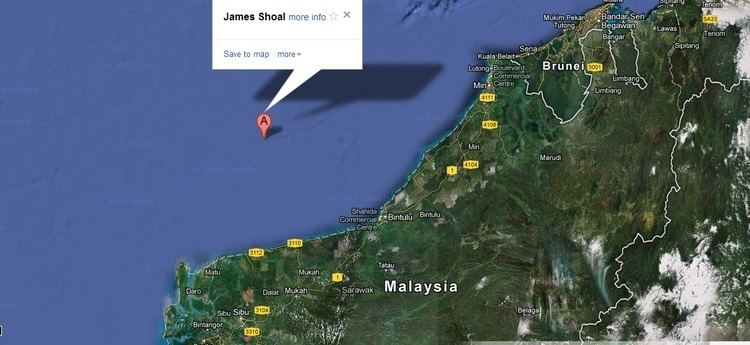Prefecture-level cityProvince SanshaHainan | Municipality Kaohsiung | |
 | ||
James Shoal, also called Beting Serupai in Malaysia and Zengmu Reef (Chinese: 曾母暗沙; pinyin: Zēngmǔ Ànshā) in Greater China, is a small bank in the South China Sea, with a depth of 22 metres (72 ft). It is claimed by Malaysia, the People's Republic of China, and the Republic of China (Taiwan). The shoal and its surroundings are administered by Malaysia.
Contents
- Map of James Shoal
- History
- Location
- Malaysias claim
- Malaysian jurisdiction
- Chinas claim
- Oil and gas reserves
- References
Map of James Shoal
History
James Shoal, along with its two nearby features, Parsons’ Shoal and Lydie Shoal, were recognised by British surveyors in the early 19th Century via many of its surveys. James Shoal first appeared on the British Admiralty Chart in the 1870s. In 1933 a government committee of the Republic of China gave Chinese names to many features in the South China Sea. These were mainly translations or transliterations of the names on the British charts. The name 'James' was transliterated as Zeng Mu (the letters 'J' and 'M'). 'Shoal' was translated as 'Tan' - meaning sandbank. It appears the Chinese committee thought, wrongly that James Shoal was an island. In 1947 the RoC changed the name to 'Ansha' - meaning 'reef'
Location
Lying about 80 km (50 mi) northwest of Bintulu, Malaysia on the Continental shelf of Borneo, the shoal is 80 kilometres (50 mi) from the Malaysian coast and about 1,800 kilometres (1,100 mi) from the Chinese mainland. Geographically, it sits south of the Spratly Islands, but is sometimes grouped with them as part of international disputes over sovereignty in the South China Sea.
The shoal is embedded in the continental shelf of Malaysia and within its EEZ.
Nearby shoals are Parsons’ Shoal and Lydie Shoal.
Malaysia's claim
Malaysia's claim on the shoal is based on the continental shelf principle, on the basis that Malaysia is the only country whose continental shelf covers James Shoal. International law defines continental shelf as a natural extension of a country’s landmass to a distance of 200 nautical miles (maximum 350 nautical miles). Drawn from the mainland or any of its islands in the South China Sea, the continental shelf of China is well short of James Shoal. Similarly, James Shoal is also not part of the extended continental shelf of Vietnam, the Philippines or Taiwan.
In May 2009, Vietnam and Malaysia put up a Joint submission on the Extended Continental Shelf to the UN Committee on the Limit of Continental Shelf (CLCS) whereby Vietnam acknowledged that James Shoal is not part of its extended continental shelf.
James Shoal is 500 nautical miles from Pagasa Island in the Spratlys that the Philippines has occupied since 1971. The Shoal is more than 400 nautical miles from Itu Aba, an island that Taiwan has occupied since 1956. James Shoal is also outside Brunei’s extended maritime zone which the 2009 Letter of Exchange Brunei had with Malaysia attested to. In 1969, Malaysia and Indonesia signed a Treaty on the continental shelf, off Tanjung Datu, Sarawak, which has placed James Shoal on the Malaysian side.
Malaysian jurisdiction
Malaysia has also effectively asserted its jurisdiction over its continental shelf including the areas in and around James Shoal, Parson’s Shoal and the Lydie Shoal. The activities of the Malaysian authorities include the construction and maintenance of a light-buoy on nearby Parson's Shoal on a 24/7 basis, daily patrolling and policing of the area by the Royal Malaysian Navy and the Malaysian Maritime Enforcement Agency and undertaking economic activities like exploration for and production of hydrocarbon resources on a sustained basis.
Under international law, such display of peaceful and continuous activities over a long period is tantamount to establishing a titre de souverain (acts of the sovereign).
China's claim
The shoal is claimed to be the southernmost territory of China by the People's Republic of China and Taiwan. China transliterated the British name as Zeng Mu Tan in 1933. It renamed it Zeng Mu Ansha in 1947. The People's Liberation Army Navy visited the shoal in May 1981, again in 1994, and in 26 March 2013. On 20 April 2010, Marine Surveillance Ship-83 placed a sovereignty stele in the maritime area of the shoal to mark it as Chinese territory.
On 28 January 2014, Chinese state news agency Xinhua reported that three Chinese warships (one amphibious landing craft and two destroyers) returned to James Shoal to conduct military drills and perform an oath swearing ceremony. The Royal Malaysian Navy chief Tan Sri Abdul Aziz Jaafar denied the report, saying that the Chinese exercise took place hundreds of miles to the north in international waters.
Chinese students are taught and tested in schools that James Shoal is the southernmost point of Chinese territory and that territory within the Nine-dash line has always belonged to China without any reference to the disputes over the islands and surrounding waters by neighbouring countries.
Oil and gas reserves
As of 2014, active exploration and development of oil and gas fields by Malaysia is taking place around the James Shoal with several production facilities erected in the surrounding area. Malaysia has also been undertaking exploration for and production of hydrocarbon resources on a sustained basis in the area, effectively asserting jurisdiction over the area.
